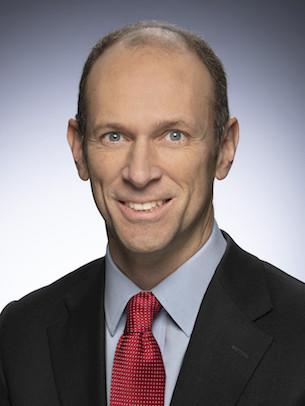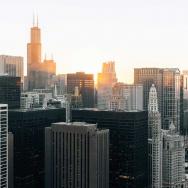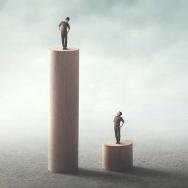In 2021, the United States faced a number of profound challenges: another year of a global pandemic, governmental instability and gridlock, supply-chain issues, high inflation, and a tight labor market complicated by the Great Resignation, to name a few.
At this year’s virtual Economic Outlook Chicago, leading University of Chicago economists Austan D. Goolsbee, Randall S. Kroszner and Raghuram G. Rajan of Chicago Booth had plenty to discuss as they forecasted what lies ahead for 2022. Held on Jan. 12, the event was the first of three global EO events hosted by the Booth School of Business.
Can the Fed handle inflation?
A few hours before the start of the event, the U.S. Department of Labor published its latest Consumer Price Index report—a measurement of what consumers pay for goods and services. The figures were bleak. Inflation rose to 7% in December, marking the third straight month that inflation exceeded 6% and the largest 12-month increase in 40 years.

The panelists didn’t mince words about the latest inflation figures—nor about what’s in store in the months ahead, both for the U.S. government and for consumers.
“We’re going to see a lot of pressure on prices continuing at least for the first six months of the year, and the Fed really needs to move,” said Kroszner, deputy dean for executive programs and the Norman R. Bobins Professor of Economics. “They’re on a path to start raising rates in March, roughly when they’ll stop the additional asset purchases. And I think it’s important that they act soon, because so far inflation expectations have not become unanchored, but they could be.”
Goolsbee, the Robert P. Gwinn Professor of Economics, said he also sees a rough road ahead for the Federal Reserve in how it attempts to tackle inflation, largely because the reasons for high inflation are complex.
“It’s still critically important that we figure out how much inflation is coming from excess demand due to fiscal and monetary stimulus and how much is coming from supply shock,” said Goolsbee, who’s also the former chairman of the Council of Economic Advisers under President Obama. “One of the lessons of the 1970s is that when you start getting supply shocks, it’s extremely uncomfortable. It’s not obvious that the Fed can fix that problem.”
Get ready for interest-rate hikes
Historically, when inflation rises in the United States, the Fed intervenes and raises interest rates in order to slow the economy and reduce inflation back to the Fed’s target level of rising between 2% and 3% annually.
For Rajan, the Katherine Dusak Miller Distinguished Service Professor of Finance, the prospect of rate hikes raises important questions for the United States: Will it be enough to put the brakes on the economy? What is the channel through which the economy slows?
“You may have enough rate hikes to slow the financial economy down in the sense that all these risky assets—cryptos, etc.—fall in price, but you still don’t get a substantial slowing in the real economy in terms of output and growth,” he said. “And so then the Fed is in a tough situation.”

If the Fed does more than it should, it could tank both the financial economy and the real economy, said Rajan, who’s also a former governor of the Reserve Bank of India. “Part of the problem is the Fed has gotten involved in a multitude of ways in the financial market. There’s only so much central banks can do. And when they claim they can do more than that, they tend to get into areas where they should not be.”
Kroszner, who previously served as a governor of the Federal Reserve Board, said he expects rates will need to be increased at least 1 percent—and possibly more. “You can have temporary inflation, whether it’s due to supply-chain disruptions or other disruptions,” he said. “But if people start losing faith in the central bank and assume that inflation is going to stay at high levels, they ask for higher wages.”
As a consequence, companies could then pass that cost onto consumers, “and that can be a very, very difficult situation for the central bank,” Kroszner warned.
What’s next for China and the supply chain?
The global supply chain began experiencing problems during the early stages of the COVID-19 pandemic. In China, many factories either reduced production or shut down entirely because of the coronavirus. This has been especially problematic for countries with high imports, because China is the world’s largest manufacturer of goods. In 2019, it accounted for about 29% of global manufacturing output.
Anticipating a drop in demand on the transportation of goods, many shipping companies reduced their workloads—just as demand from American consumers went up, in part because of government stimulus. Two years later, global supply-chain problems persist, and the stability of China’s economy remains tenuous as a consequence of the pandemic and its ripple effects.
“If people start losing faith in the central bank and assume that inflation is going to stay at high levels, they ask for higher wages.”
“What’s going on in China is certainly unprecedented,” Rajan said. “Their old method of reviving their economy when it’s in trouble was to reduce rates and lend to the real-estate sector, creating a lot of demand for steel, copper, and everything else. That’s no longer effective, especially because of overbuilding. ... I think we have to watch the China space very carefully. There will be disinflationary impulses coming from China if they can’t manage this well.”
One other potential problem for China in the coming years, Kroszner added, is the rapid aging of its population. Building off of Rajan’s insights, Kroszner acknowledged that fewer people translates into fewer buyers of real estate. That, Kroszner said, “is going to slow overall economic activity because the massive increase in the labor force had been a key factor driving previous high rates of growth in China. You have the slowing impact of a step down in the growth of the labor force, in addition to the geopolitical uncertainties, which I think are very real.”
Pandemic-induced instability
All three panelists expressed deep concerns about the stability of governments and international order in the year ahead. The likelihood of a hot war somewhere in the world in 2022 “is very high,” Kroszner said.
In addition to sharing Kroszner’s concern, Rajan noted that the pandemic has devasted many emerging and developing economies, in part because of limited vaccine access, and because many middle-class families have fallen into poverty. These problems have manifested into angry citizens in many countries who look to extreme candidates on both sides of the political spectrum for solutions, leading to societal instability.
“I think that across the world we will see, as people are able to come out on the streets, more and more of the effects of the pandemic demonstrated in political conflict and political discussion,” Rajan said. “And that allows for the possibility of countries meddling to get allies.”

Examining the state of politics in the United States, Goolsbee said he thinks president Joe Biden is likely to experience a tough time passing additional large pieces of legislation in his first term. The U.S. political system is one in which, as president, Goolsbee said, virtually everything you’re going to do legislatively is going to get done the first year in office.
“It was true for Obama and Trump, and it will be for Biden,” he said. “That’s the most fun you’re ever going to have as president. It’s only going to get worse. You’re going to lose the midterm. Then your own party is going to distance themselves from you. The media’s going to treat you worse. Everything gets worse and worse until you’re done. Then they revive your reputation once you’re out of office. That’s the system we have. It’s like in The Godfather—this is the business we’ve chosen.”
‘The virus is the boss’
The United States faces a number of challenges in 2022, the panelists concluded, many of which carry over from 2021: continuing inflation, a tight labor market, political gridlock in Washington, instability at home and abroad, and the global pandemic, which is now entering its third year.
While Rajan and Kroszner expressed concerns about any high degree of fiscal stimulus continuing in 2022, Goolsbee cautioned to the audience the consequences of the coronavirus continuing to rage in the United States.
“The virus is the boss,” Goolsbee said. “I’ve been saying it from the beginning: When the virus surges, the economy is going to stall out. The job market’s going to stall out. The service sector is going to stall out.” If we get control of the virus, Goolsbee said, that will help balance the economy and GDP growth will rise. However, “if we’re meeting via Zoom” again for Economic Outlook 2023, he said, “then all bets are off.”
—This story was first published by the Booth School of Business











